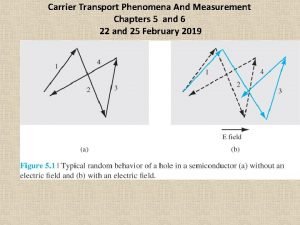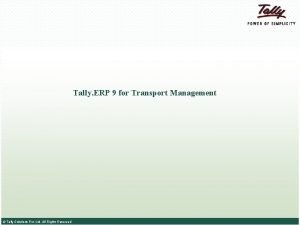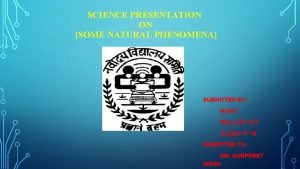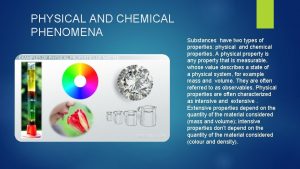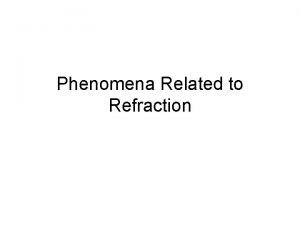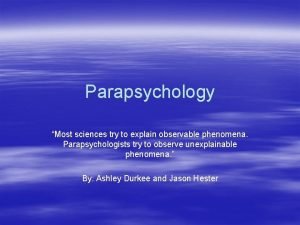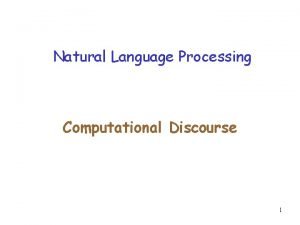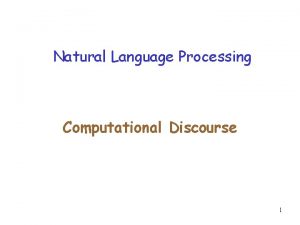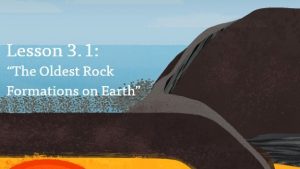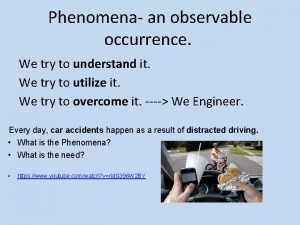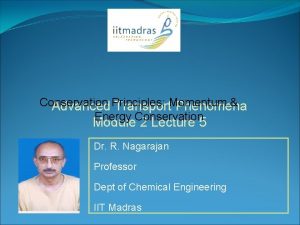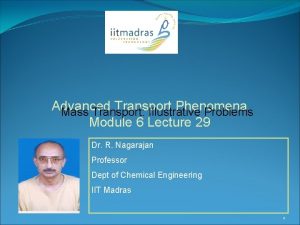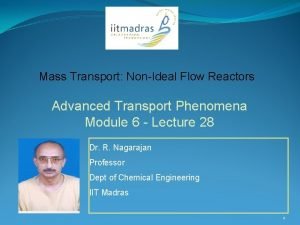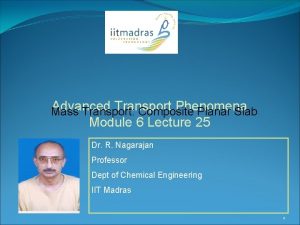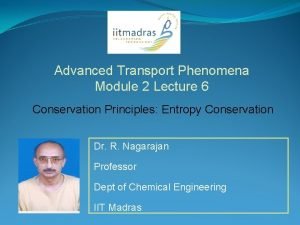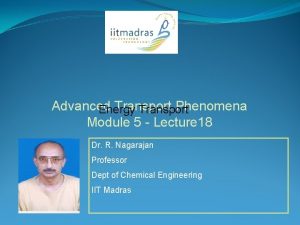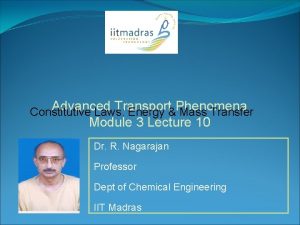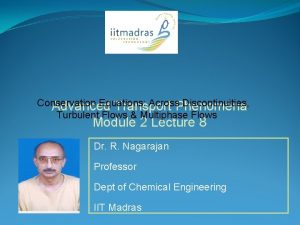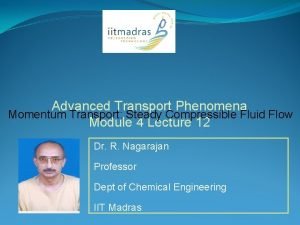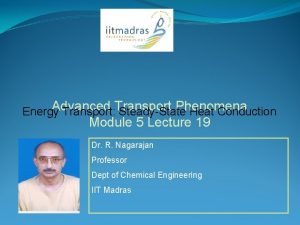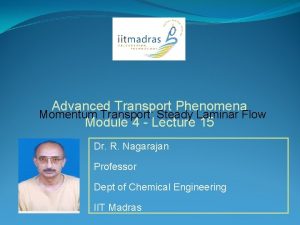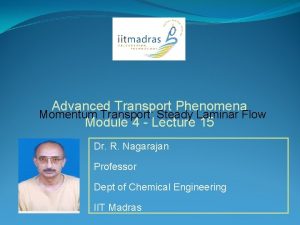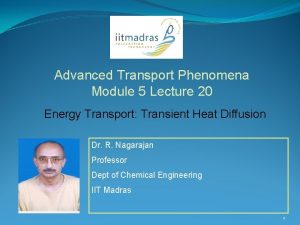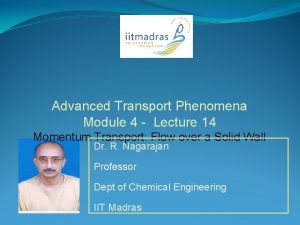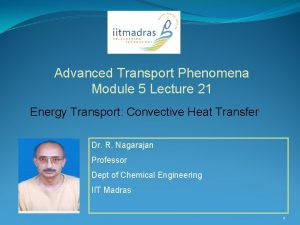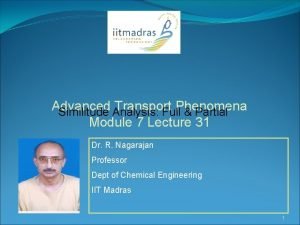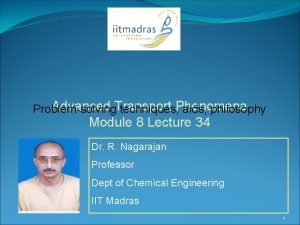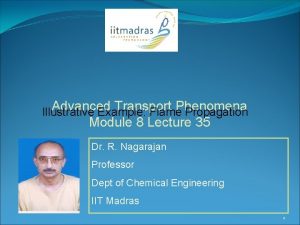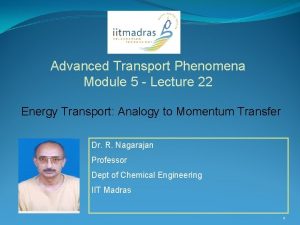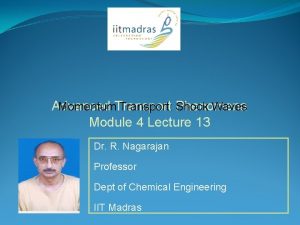Advanced Principles Transport Phenomena Conservation Mass Conservation Module


























- Slides: 26

Advanced. Principles: Transport Phenomena Conservation Mass Conservation Module 2 Lecture 4 Dr. R. Nagarajan Professor Dept of Chemical Engineering IIT Madras

CONSERVATION EQUATIONS

FORM OF EQUATION IN FIXED, MACROSCOPIC CV where ( ) applies to: ØMass, ØMomentum, ØEnergy, or ØEntropy

USES OF MACROSCOPIC CV EQUATIONS CONTD… ØTo test predictions or measurements for overall conservation ØTo solve “black box” problems ØTo derive finite-difference (element) equations using arbitrary, coarse meshes ØAs a starting point for deriving multiphase flow conservation equations ØAt discontinuities, provide “jump conditions” and appropriate boundary conditions Øe. g. , shock waves, flames, etc.

FORM OF EQUATION IN FIXED, DIFFERENTIAL CV ØDivide each term in macroscopic CV equation by V, and pass to the limit V 0 Øe. g. , in cartesian coordinates, divide by Dx Dy Dz ØLocal “divergence” of ( ) is defined by:

FORM OF EQUATION IN FIXED, DIFFERENTIAL CV CONTD… Ødiv ( ) = local outflow associated with the flux of ( ), calculated on a per-unit-volume basis Ø- div ( ) = net inflow per unit volume ØPDE’s result

USES OF DIFFERENTIAL CV EQUATIONS ØPredict detailed distribution of flow properties within region of interest ØExtract flux laws/ coefficients from measurements in simple flow systems ØProvide basis dimensionless for estimating parameters chemically reacting flow important governing a

USES OF DIFFERENTIAL CV EQUATIONS CONTD… ØDerive finite-difference (algebraic) equations for numerically approximating field densities ØDerive entropy production expression and provide guidance for proper choice of constitutive laws

MASS CONSERVATION ØTotal Mass Conservation ØChemical Species Mass Conservation ØChemical Element Mass Conservation

TOTAL MASS CONSERVATION ØSimplest ØCannot be created or consumed by chemical reactions ØCannot diffuse ØConservation equation is, therefore, simplified to two terms:

TOTAL MASS CONSERVATION CONTD… ØOr, mathematically, as the following integral constraint: where r v. n d. A mass flow through area n d. A per unit time, and Integral summation over all such control surface elements in overall CS

FIXED (EULERIAN) CONTROL VOLUME

TOTAL MASS CONSERVATION CONTD… ØFormulation in differential CV (local PDE): Ø“continuity” equation ØAlso applies across “surface of discontinuity”, which may itself be moving: Øe. g. , premixed flame front ØExpressed per unit area of surface ØUsually, accumulation term negligible

TOTAL MASS CONSERVATION CONTD… ØEq. for surface of discontinuity simplifies to:

CHEMICAL SPECIES MASS CONSERVATION ØMass transport can occur by diffusion as well as convection ØNet production (generation – consumption) is a result of all homogeneous reactions ØConservation equation in Fixed CV:

CHEMICAL SPECIES MASS CONSERVATION CONTD… ØDefinitions: ØConvective flux of species mass = ri v = wi r v ØTotal local flux of species i = ØDiffusion flux of species i, ji” = - ri v ØNet rate of production of species i mass per unit volume (via homogeneous chemical reactions) =

CHEMICAL SPECIES MASS CONSERVATION CONTD… ØIn PDE form:

CHEMICAL SPECIES MASS CONSERVATION CONTD… Ø“Jump condition” for surface of discontinuity:

CHEMICAL SPECIES MASS CONSERVATION CONTD… “Pillbox” Control Volume

CHEMICAL SPECIES MASS CONSERVATION CONTD… ØAll but one of N species mass balance equations are independent of total mass balance.

CHEMICAL SPECIES MASS CONSERVATION CONTD… ØWhen some chemical species are ionic in nature (e. g. , solution electrochemistry, electrical discharges in gases, etc. ), principle of “electric charge conservation” comes into effect.

CHEMICAL ELEMENT MASS CONSERVATION ØUsed widely in analysis of chemically reacting flows: ØFewer in number ØConservation equations identical in form to those governing inert (e. g. , tracer) species

CHEMICAL ELEMENT MASS CONSERVATION CONTD… Ø Similar in structure to species conservation equation, except that…. Ø For conventional (extra-nuclear) chemical reactions, no element can be locally produced, however complex the reaction. Ø Elements can “change partners”

CHEMICAL ELEMENT MASS CONSERVATION Ø kth element conservation equation for a fixed macroscopic CV is thus “source-free”: Ø = diffusion flux of kth element = weighted sum of fluxes of chemical species containing element k

CHEMICAL ELEMENT MASS CONSERVATION CONTD… Økth element conservation law in local PDE form: Ø“Jump condition” for kth element mass transfer across surface of discontinuity:

CHEMICAL ELEMENT MASS CONSERVATION CONTD… ØAll but one of Nelement mass balance equations are independent of total mass balance.
 Carrier transport phenomena
Carrier transport phenomena Https://slidetodoc.com
Https://slidetodoc.com Primary transport and secondary transport
Primary transport and secondary transport Active transport
Active transport Now answer the following questions
Now answer the following questions Active transport vs passive transport venn diagram
Active transport vs passive transport venn diagram Unlike passive transport, active transport requires
Unlike passive transport, active transport requires Primary active transport vs secondary active transport
Primary active transport vs secondary active transport Bioflix activity membrane transport active transport
Bioflix activity membrane transport active transport Active transport image
Active transport image Bioflix activity membrane transport active transport
Bioflix activity membrane transport active transport Tally transport module download
Tally transport module download Optical transport module
Optical transport module Synchronous transport module
Synchronous transport module C device module module 1
C device module module 1 Phenomenon monikko
Phenomenon monikko Class 8 some natural phenomena ppt
Class 8 some natural phenomena ppt Physical and chemical phenomena
Physical and chemical phenomena Refraction phenomena
Refraction phenomena Observable phenomenon
Observable phenomenon Contemporary phenomenon examples
Contemporary phenomenon examples Reference phenomenon in nlp
Reference phenomenon in nlp Reference phenomena in nlp
Reference phenomena in nlp Examples of colloids
Examples of colloids Gravitation is a natural phenomenon where
Gravitation is a natural phenomenon where Anchor phenomena
Anchor phenomena Observable phenomena
Observable phenomena
